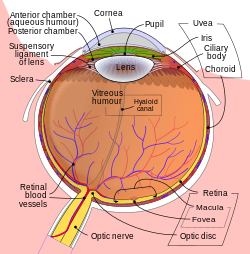Vitreous humour
| Vitreous humour | |
|---|---|

Schematic diagram of the human eye.
|
|
| Details | |
| Identifiers | |
| Latin | humor vitreus |
| TA |
A15.2.06.014 A15.2.06.008 |
| FMA | 67388 |
|
Anatomical terminology
[]
|
|
The vitreous body is the clear gel that fills the space between the lens and the retina of the eyeball of humans and other vertebrates. It is often referred to as the vitreous humour or simply "the vitreous".
The vitreous humour is a transparent, colorless, gelatinous mass that fills the space in the eye between the lens and the retina. It is present at birth. Produced by cells in the non-pigmented portion of the ciliary body, the vitreous humour is derived from embryonic mesenchyme cells, which degenerate after birth.
The vitreous humour is in contact with the retina and helps to keep it in place by pressing it against the choroid. It does not adhere to the retina, except at the optic nerve disc and the ora serrata (where the retina ends anteriorly), at the Wieger-band, the dorsal side of the lens. It is not connected at the macula, the area of the retina which provides finer detail and central vision.
Unlike the fluid in the frontal parts of the eye (aqueous humour) which is continuously replenished, the gel in the vitreous chamber is stagnant. Therefore, if blood, cells or other byproducts of inflammation get into the vitreous, they will remain there unless removed surgically. These are known as floaters. If the vitreous pulls away from the retina, it is known as a vitreous detachment. As the human body ages, the vitreous often liquefies and may collapse. This is more likely to occur, and occurs much earlier, in eyes that are nearsighted (myopia). It can also occur after injuries to the eye or inflammation in the eye (uveitis).
The collagen fibres of the vitreous are held apart by electrical charges. With aging, these charges tend to reduce, and the fibres may clump together. Similarly, the gel may liquefy, a condition known as synaeresis, allowing cells and other organic clusters to float freely within the vitreous humour. These allow floaters which are perceived in the visual field as spots or fibrous strands. Floaters are generally harmless, but the sudden onset of recurring floaters may signify a posterior vitreous detachment (PVD) or other diseases of the eye.
...
Wikipedia
